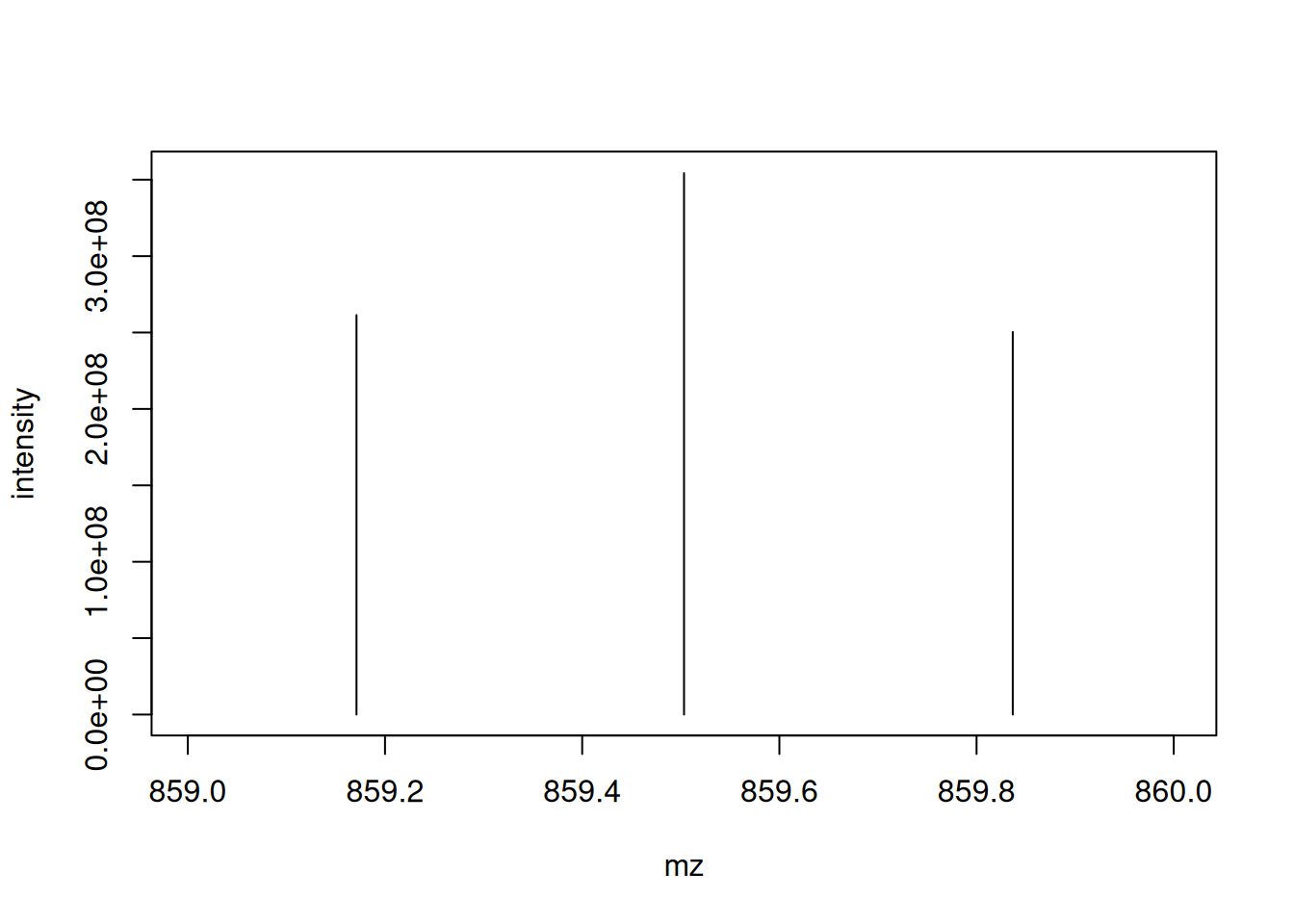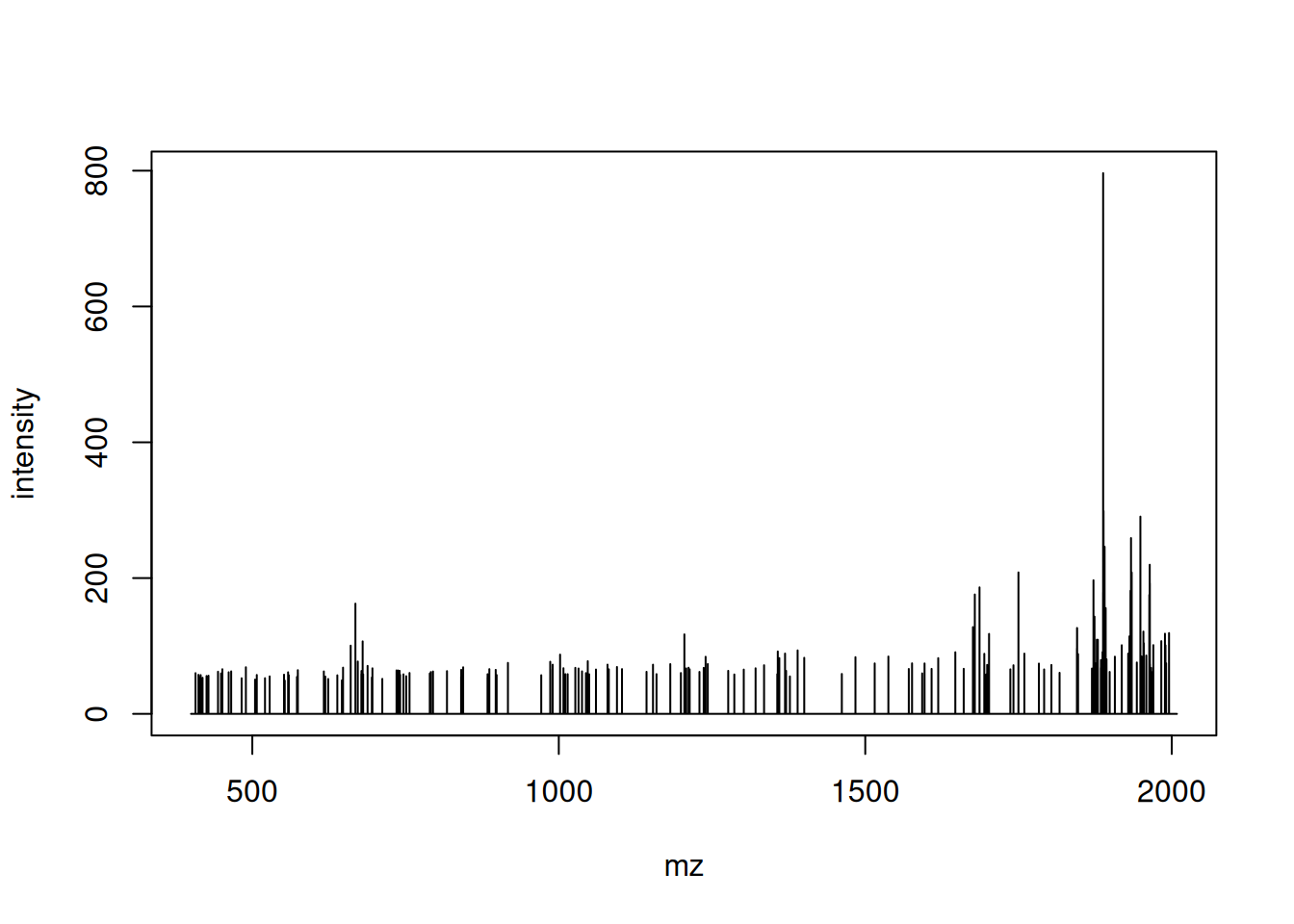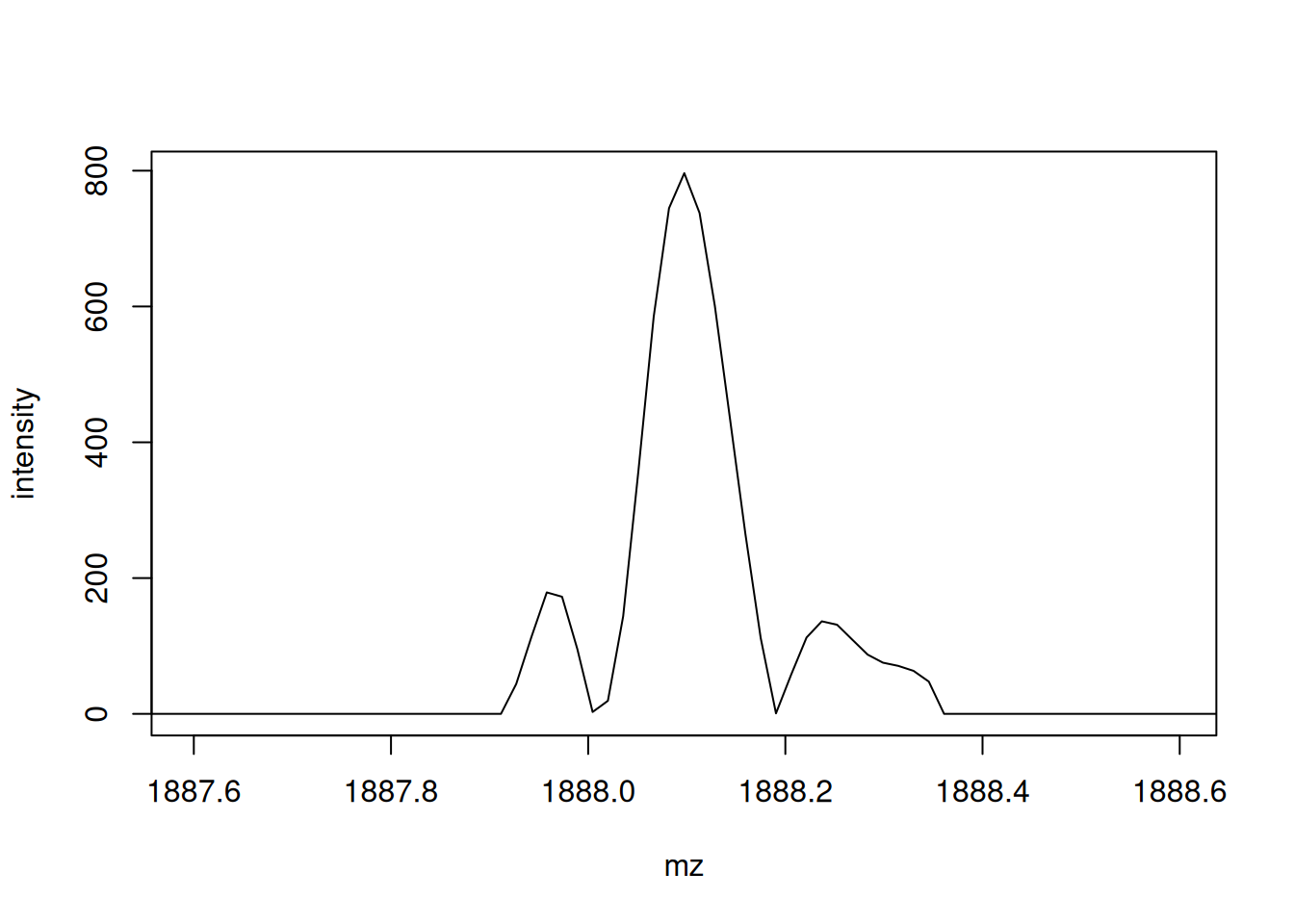Chapter 7 Annex
7.1 Raw MS data under the hood: the mzR package
The mzR package is a direct interface to the
proteowizard code base. It
includes a substantial proportion of pwiz’s C/C++ code for fast and
efficient parsing of these large raw data files.
Let’s start by using some raw data files from the msdata
package. After loading it, we use the proteomics() function to
return the full file names for two raw data files. We will start by
focusing on the second one.
## Loading PXD000001 from cache.## Loading TMT_Erwinia_1uLSike_Top10HCD_isol2_45stepped_60min_01-20141210.mzML from cache.## [1] "c83ad32ce6d20_TMT_Erwinia_1uLSike_Top10HCD_isol2_45stepped_60min_01-20141210.mzML"The three main functions of mzR are
-
openMSfileto create a file handle to a raw data file -
headerto extract metadata about the spectra contained in the file -
peaksto extract one or multiple spectra of interest.
Other functions such as instrumentInfo, or runInfo can be used to
gather general information about a run.
## Mass Spectrometry file handle.
## Filename: c83ad32ce6d20_TMT_Erwinia_1uLSike_Top10HCD_isol2_45stepped_60min_01-20141210.mzML
## Number of scans: 7534## [1] 7534 32## [1] "seqNum" "acquisitionNum"
## [3] "msLevel" "polarity"
## [5] "peaksCount" "totIonCurrent"
## [7] "retentionTime" "basePeakMZ"
## [9] "basePeakIntensity" "collisionEnergy"
## [11] "electronBeamEnergy" "ionisationEnergy"
## [13] "lowMZ" "highMZ"
## [15] "precursorScanNum" "precursorMZ"
## [17] "precursorCharge" "precursorIntensity"
## [19] "mergedScan" "mergedResultScanNum"
## [21] "mergedResultStartScanNum" "mergedResultEndScanNum"
## [23] "injectionTime" "filterString"
## [25] "spectrumId" "centroided"
## [27] "ionMobilityDriftTime" "isolationWindowTargetMZ"
## [29] "isolationWindowLowerOffset" "isolationWindowUpperOffset"
## [31] "scanWindowLowerLimit" "scanWindowUpperLimit"## mz intensity
## [1,] 399.9976 0
## [2,] 399.9991 0
## [3,] 400.0006 0
## [4,] 400.0021 0
## [5,] 400.2955 0
## [6,] 400.2970 0## List of 5
## $ : num [1:25800, 1:2] 400 400 400 400 400 ...
## ..- attr(*, "dimnames")=List of 2
## .. ..$ : NULL
## .. ..$ : chr [1:2] "mz" "intensity"
## $ : num [1:25934, 1:2] 400 400 400 400 400 ...
## ..- attr(*, "dimnames")=List of 2
## .. ..$ : NULL
## .. ..$ : chr [1:2] "mz" "intensity"
## $ : num [1:26148, 1:2] 400 400 400 400 400 ...
## ..- attr(*, "dimnames")=List of 2
## .. ..$ : NULL
## .. ..$ : chr [1:2] "mz" "intensity"
## $ : num [1:26330, 1:2] 400 400 400 400 400 ...
## ..- attr(*, "dimnames")=List of 2
## .. ..$ : NULL
## .. ..$ : chr [1:2] "mz" "intensity"
## $ : num [1:26463, 1:2] 400 400 400 400 400 ...
## ..- attr(*, "dimnames")=List of 2
## .. ..$ : NULL
## .. ..$ : chr [1:2] "mz" "intensity"► Question
Let’s extract the index of the MS2 spectrum with the highest base peak intensity and plot its spectrum. Is the data centroided or in profile mode?
► Solution
► Question
Pick an MS1 spectrum and visually check whether it is centroided or in profile mode.
► Solution
7.2 PSM data under the hood
There are two packages that can be used to parse mzIdentML files,
namely mzR (that we have already used for raw data) and mzID. The
major difference is that the former leverages C++ code from
proteowizard and is hence faster than the latter (which uses the
XML R package). They both work in similar ways.
|Data type |File format |Data structure |Package |
|:--------------|:-----------|:--------------|:-------|
|Identification |mzIdentML |mzRident |mzR |
|Identification |mzIdentML |mzID |mzID |Which of these packages is used by PSM() can be defined by the
parser argument, as documented in ?PSM.
mzID
The main functions are mzID to read the data into a dedicated data
class and flatten to transform it into a data.frame.
## EH7807
## "/home/lgatto/.cache/R/ExperimentHub/418921373f689_7857"##
## Attaching package: 'mzID'## The following object is masked from 'package:purrr':
##
## flatten## The following object is masked from 'package:dplyr':
##
## id## reading 418921373f689_7857...## DONE!## An mzID object
##
## Software used: MS-GF+ (version: Beta (v10072))
##
## Rawfile: /home/lg390/dev/01_svn/workflows/proteomics/TMT_Erwinia_1uLSike_Top10HCD_isol2_45stepped_60min_01-20141210.mzML
##
## Database: /home/lg390/dev/01_svn/workflows/proteomics/erwinia_carotovora.fasta
##
## Number of scans: 5343
## Number of PSM's: 5656Various data can be extracted from the mzID object, using one of the
accessor functions such as database, software, scans, peptides,
… The object can also be converted into a data.frame using the
flatten function.
## spectrumid scan number(s) acquisitionnum
## 1 controllerType=0 controllerNumber=1 scan=5782 5782 5782
## 2 controllerType=0 controllerNumber=1 scan=6037 6037 6037
## 3 controllerType=0 controllerNumber=1 scan=5235 5235 5235
## passthreshold rank calculatedmasstocharge experimentalmasstocharge
## 1 TRUE 1 1080.232 1080.233
## 2 TRUE 1 1002.212 1002.209
## 3 TRUE 1 1189.280 1189.284
## chargestate ms-gf:denovoscore ms-gf:evalue ms-gf:pepqvalue ms-gf:qvalue
## 1 3 174 1.086033e-20 0 0
## 2 3 245 1.988774e-19 0 0
## 3 3 264 5.129649e-19 0 0
## ms-gf:rawscore ms-gf:specevalue assumeddissociationmethod isotopeerror
## 1 147 3.764831e-27 HCD 0
## 2 214 6.902626e-26 HCD 0
## 3 211 1.778789e-25 HCD 0
## isdecoy post pre end start accession length
## 1 FALSE S R 84 50 ECA1932 155
## 2 FALSE R K 315 288 ECA1147 434
## 3 FALSE A R 224 192 ECA0013 295
## description pepseq
## 1 outer membrane lipoprotein PVQIQAGEDSNVIGALGGAVLGGFLGNTIGGGSGR
## 2 trigger factor TQVLDGLINANDIEVPVALIDGEIDVLR
## 3 ribose-binding periplasmic protein TKGLNVMQNLLTAHPDVQAVFAQNDEMALGALR
## modified modification idFile
## 1 FALSE <NA> 418921373f689_7857
## 2 FALSE <NA> 418921373f689_7857
## 3 FALSE <NA> 418921373f689_7857
## spectrumFile
## 1 TMT_Erwinia_1uLSike_Top10HCD_isol2_45stepped_60min_01-20141210.mzML
## 2 TMT_Erwinia_1uLSike_Top10HCD_isol2_45stepped_60min_01-20141210.mzML
## 3 TMT_Erwinia_1uLSike_Top10HCD_isol2_45stepped_60min_01-20141210.mzML
## databaseFile
## 1 erwinia_carotovora.fasta
## 2 erwinia_carotovora.fasta
## 3 erwinia_carotovora.fasta
## [ reached 'max' / getOption("max.print") -- omitted 3 rows ]
mzR
The mzR interface provides a similar interface. It is however much
faster as it does not read all the data into memory and only extracts
relevant data on demand. It has also accessor functions such as
softwareInfo, mzidInfo, … (use showMethods(classes = "mzRident", where = "package:mzR"))
to see all available methods.
## Identification file handle.
## Filename: 418921373f689_7857
## Number of psms: 5759## [1] "MS-GF+ Beta (v10072) "
## [2] "ProteoWizard MzIdentML 3.0.21263 ProteoWizard"The identification data can be accessed as a data.frame with the
psms accessor.
## spectrumID chargeState rank passThreshold
## 1 controllerType=0 controllerNumber=1 scan=5782 3 1 TRUE
## 2 controllerType=0 controllerNumber=1 scan=6037 3 1 TRUE
## 3 controllerType=0 controllerNumber=1 scan=5235 3 1 TRUE
## 4 controllerType=0 controllerNumber=1 scan=5397 3 1 TRUE
## 5 controllerType=0 controllerNumber=1 scan=6075 3 1 TRUE
## experimentalMassToCharge calculatedMassToCharge
## 1 1080.2325 1080.2321
## 2 1002.2089 1002.2115
## 3 1189.2836 1189.2800
## 4 960.5365 960.5365
## 5 1264.3409 1264.3419
## sequence peptideRef modNum isDecoy post pre start
## 1 PVQIQAGEDSNVIGALGGAVLGGFLGNTIGGGSGR Pep1 0 FALSE S R 50
## 2 TQVLDGLINANDIEVPVALIDGEIDVLR Pep2 0 FALSE R K 288
## 3 TKGLNVMQNLLTAHPDVQAVFAQNDEMALGALR Pep3 0 FALSE A R 192
## 4 SQILQQAGTSVLSQANQVPQTVLSLLR Pep4 0 FALSE - R 264
## 5 PIIGDNPFVVVLPDVVLDESTADQTQENLALLISR Pep5 0 FALSE F R 119
## end DatabaseAccess DBseqLength DatabaseSeq
## 1 84 ECA1932 155
## 2 315 ECA1147 434
## 3 224 ECA0013 295
## 4 290 ECA1731 290
## 5 153 ECA1443 298
## DatabaseDescription scan.number.s.
## 1 ECA1932 outer membrane lipoprotein 5782
## 2 ECA1147 trigger factor 6037
## 3 ECA0013 ribose-binding periplasmic protein 5235
## 4 ECA1731 flagellin 5397
## 5 ECA1443 UTP--glucose-1-phosphate uridylyltransferase 6075
## acquisitionNum
## 1 5782
## 2 6037
## 3 5235
## 4 5397
## 5 6075
## [ reached 'max' / getOption("max.print") -- omitted 1 rows ]Page built: 2025-11-19 using R version 4.5.0 (2025-04-11)



